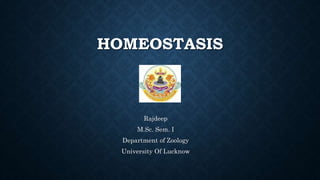
homeostasis.pptx
- 1. HOMEOSTASIS Rajdeep M.Sc. Sem. I Department of Zoology University Of Lucknow
- 2. Maintenance of nearly constant conditions in the internal environment of the body is termed as Homeostasis. Homeostasis is “unchanging,” the term does not really mean a static, or unchanging, state. Rather, it indicates a dynamic state of equilibrium, or a balance, in which internal conditions vary, but always within relatively narrow limits. Walter Cannon, an American physiologist of the early twentieth century, spoke of the “wisdom of the body,” and he coined the term homeostasis . “ The various physiological arangements which serve to restore the normal state , once it has been disturbed ” , are know as Homeostasis Mechanisms. HOMEOSTASIS
- 3. What needs to be maintained constant in the internal environment of the body ? Concentration of oxygen & carbon dioxide . pꓧ of the internal environment . Concentration of nutrients & waste products. Concentration of salts & other electrolytes . Volume & pressure of the extracellular fluid . Temperature of internal environment. Organs & organ system of the body involved in maintenance of Homeostasis. Cardiovascular system . Respiratory system . Nervous system. Endocrine system. Gastrointestinal system . Skeletal system . Integumentry system . Reproductive system Excretory system . All the Organs & organ system of the body involved in maintenance of Homeostasis.
- 4. HOW DOES HOMEOSTATIC CONTROL MECHANISM WORK ?
- 5. All homeostatic control mechanisms have at least three interdependent components . The first component, the receptor, is some type of sensor that monitors the environment and responds to changes, called stimuli, by sending information (input) to the second component, the control center. Input flows from the receptor to the control center along the so-called afferent pathway. The control center, which determines the set point (the level or range at which a variable is to be maintained), analyzes the input it receives and then determines the appropriate response or course of action. The third component, the effector, provides the means for the control center’s response (output) to the stimulus. Information flows from the control center to the effector along the efferent pathway. The results of the response then feed back to influence the stimulus, either depressing it (negative feedback) so that the whole control mechanism is shut off or enhancing it (positive feedback) so that the reaction continues at an even faster rate. Homeostasis involves mostly two mechanisms : (1) Negative Control Mechanisms (2) Positive Control Mechanisms
- 6. NEGATIVE FEEDBACK MECHANISMS Most homeostatic control mechanisms are negative feedback mechanisms. In these systems, the output shuts off the original stimulus or reduces its intensity. These mechanisms cause the variable to change in a direction opposite to that of the initial change, returning it to its “ideal” value; thus the name “negative” feedback mechanisms. The body’s ability to regulate its internal environment is fundamental, and all negative feedback mechanisms have the same goal: preventing sudden severe changes within the body. Negative feedback mechanisms reduce the original stimulus, and are essential for maintaining homeostasis. Body temperature, heart rate, breathing rate and depth, and blood levels of glucose and certain ions are regulated by negative feedback mechanisms
- 8. POSITIVE FEEDBACK MECHANISM In positive feedback mechanisms, the result or response enhances the original stimulus so that the activity (output) is accelerated. This feedback mechanism is “positive” because the change that occurs proceeds in the same direction as the initial disturbance, causing the variable to deviate further and further from its original value or range. In contrast to negative feedback controls, which maintain some physiological function or keep blood chemicals within narrow ranges, positive feedback mechanisms usually control infrequent events that do not require continuous adjustments. Typically, they set off a series of events that may be self-perpetuating and that, once initiated, have an amplifying or waterfall effect. Positive feedback mechanisms intensify the initial stimulus, leading to an enhancement of the response. They rarely contribute to homeostasis, but blood clotting and labor contractions are regulated by such mechanisms.
- 10. Significance of Homeostasis Homeostasis is so important that most disease can be regarded as a result of its disturbance, a condition called homeostatic imbalance. As we age, our body’s control systems become less efficient, and our internal environment becomes less and less stable. These events increase our risk for illness and produce the changes we associate with aging. Another important source of homeostatic imbalance occurs when the usual negative feedback mechanisms are overwhelmed and destructive positive feedback mechanisms take over. Some instances of heart failure reflect this phenomenon.
- 11. Thank You…….
Editor's Notes
- What needs to be maintained constant in the internal environment of the body ? Concentration of oxygen & carbon dioxide . pꓧ of the internal environment . Concentration of nutrients & waste products. Concentration of salts & other electrolytes . Volume & pressure of the extracellular fluid . Temperature of internal environment.
- ….